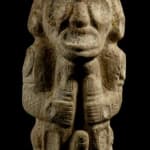Taino Stone Zemi Sculpture, 1000 CE - 1500 CE
Stone
7 x 15.8
LO.1322
This remarkable sculpture of a zemi figure is carved from a pale green/brown stone. A zemi was the physical manifestation of a Taino god, spirit or ancestor. As chieftains and...
This remarkable sculpture of a zemi figure is carved from a pale green/brown stone. A zemi was the physical manifestation of a Taino god, spirit or ancestor. As chieftains and important shamans were deified after death it may even represent a high status member of the Taino community. The arrangement of the figure’s limbs is extraordinary and is an elaboration of the ritual squatting position that zemis assume in surviving stone amulets. In this case the legs are held up vertically with the feet resting just under the chin. The hands hold the legs in position, clutching them at approximately knee-level. Both the face and the body are skeletal in appearance with prominent hollow joints. The wide eye-sockets and gaping jaw are deeply carved and both the forehead and the chin project outwards at a sharp angle. The emanciated look continues on the reverse, which is flat rather than carved in the round. Both the ribs and the spine are indicated, set between elaborate geometric motifs which may indicate the presence of tattoos. The figure rests on a pedestal that also features a band of complex abstract design.
To western sensibilities there is an obvious contradiction between the figure’s skeletal form, suggestive of death and decay, and the fleshy, erect phallus just above the pedestal. The latter is clearly a symbol of potency and fertility that seems oddly juxtaposed with bodily indicators of old age. However it was not unusual in the New World to combine such iconography. Parallels have been drawn with the pottery vessels from the ancient Moche civilization of Peru, which depict well-built women in the company of skeletal males with erect phalluses. As Peter Roe has argued, ‘In the New World, the iconography of mortality was linked to images of fecundity.’
A carving of this complexity and size must have belonged to a chieftain or member of his retinue. Although the Taino left no written records, the Spanish settlers did record native practices (though they did not necessarily understand their significance). One eye-witness refers to special structures or temples in which the chieftains stored their zemi carvings. The Taino believed in the existence of an afterlife and the ability of shamans to communicate with the dead. This sculpture may well have been a prop in such a ceremony, or a focus for ancestor worship. This is a remarkably evocative work that allows us to glimpse some of the splendours of Taino civilization. (AM)
To western sensibilities there is an obvious contradiction between the figure’s skeletal form, suggestive of death and decay, and the fleshy, erect phallus just above the pedestal. The latter is clearly a symbol of potency and fertility that seems oddly juxtaposed with bodily indicators of old age. However it was not unusual in the New World to combine such iconography. Parallels have been drawn with the pottery vessels from the ancient Moche civilization of Peru, which depict well-built women in the company of skeletal males with erect phalluses. As Peter Roe has argued, ‘In the New World, the iconography of mortality was linked to images of fecundity.’
A carving of this complexity and size must have belonged to a chieftain or member of his retinue. Although the Taino left no written records, the Spanish settlers did record native practices (though they did not necessarily understand their significance). One eye-witness refers to special structures or temples in which the chieftains stored their zemi carvings. The Taino believed in the existence of an afterlife and the ability of shamans to communicate with the dead. This sculpture may well have been a prop in such a ceremony, or a focus for ancestor worship. This is a remarkably evocative work that allows us to glimpse some of the splendours of Taino civilization. (AM)



